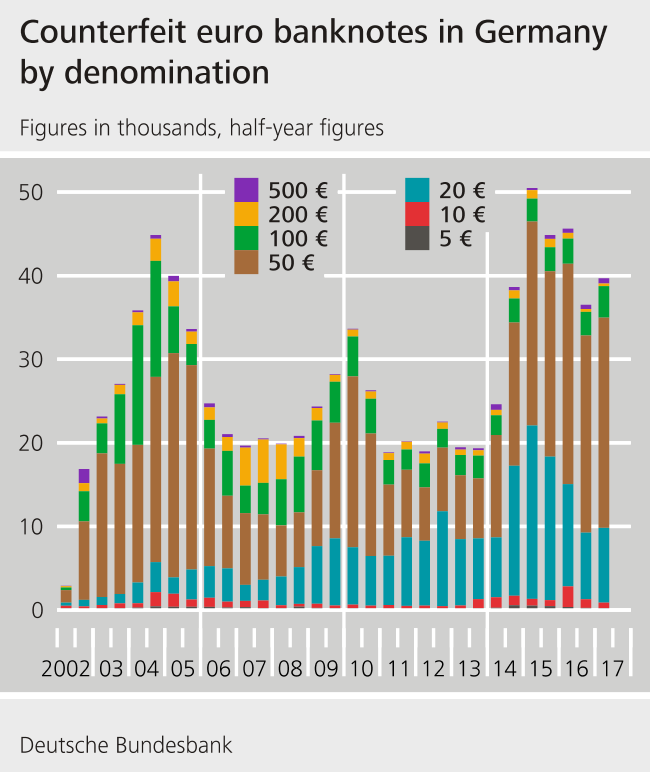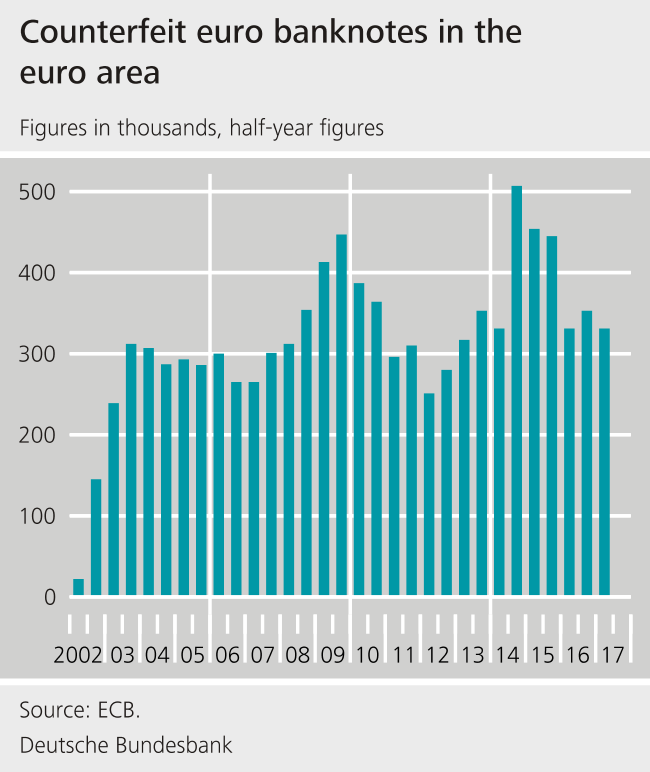More counterfeits in circulation
In the first half of 2017, the Bundesbank withdrew around 39,700 counterfeit euro banknotes with a value of €2.2 million from circulation, which is an increase of 8.7% on the second half of 2016. Statistically, this equates to around ten counterfeit banknotes per 10,000 inhabitants in Germany per year. The number of counterfeit €50 notes of the first series of euro banknotes went up in particular, with this denomination accounting for just under two-thirds of all counterfeit banknotes in the first six months of 2017.
The incidence of counterfeit euro banknotes in the first half of 2017 can be broken down as follows.
| Notes | Number | Share (rounded) |
| €5 | 225 |
1 % |
| €10 | 651 |
2 % |
| €20 | 8,954 |
23 % |
| €50 | 25,147 |
63 % |
| €100 | 3,767 |
9 % |
| €200 | 316 |
1 % |
| €500 | 625 |
2 % |
| Total | 39,685 |
"Although the current figures for counterfeits have shown an increase in the first half of the year, I am expecting the number of €50 counterfeits to go down in the second half of the year,
" said Bundesbank Executive Board member Carl-Ludwig Thiele. In April, the new €50 banknote of the second series, which is deemed to be particularly counterfeit-proof owing to a number of new security features, was introduced. "I am expecting the counterfeit figures to follow a pattern similar to that seen following the introduction of the new €20 banknote in November 2015 when the number of counterfeits of this denomination dropped significantly,
" Mr Thiele added.
Number of counterfeit coins has also risen
In the first half of 2017, approximately 18,500 counterfeit coins were detected in German payments, compared with 14,340 in the previous six-month period. Statistically, this equates to around four counterfeit coins per 10,000 inhabitants in Germany per year. The €2 coin was the most frequently counterfeited coin denomination, accounting for 82% of the total.
Counterfeits were identified only in the three highest denominations, and their incidence in the first six months of 2017 was as follows.
| Coins | Number | Share (rounded) |
| 50 cents | 707 |
4% |
| €1 | 2,569 |
14% |
| €2 | 15,229 |
82% |
| Total | 18,505 |
Fewer counterfeit banknotes in the euro area
According to information from the European Central Bank the overall number of counterfeit banknotes recorded in the euro area has fallen and remains at a low level. Some 331,000 counterfeit banknotes were withdrawn from circulation in the first half of 2017. Around 85% of all recorded counterfeits were €20 or €50 banknotes. Compared with the number of genuine euro banknotes, the proportion of counterfeits is very low: currently there are over 20 billion euro banknotes in circulation, with a total value of €1.1 trillion.
Checking banknotes for authenticity
The Bundesbank advises that banknotes and coins should be checked carefully at all times. As counterfeit money is non-refundable, banknotes should be checked for authenticity using the "feel, look and tilt" method. There are a number of different security features that should be checked in the process:
Raised print on the front of the banknotes can be identified by touch.
- First series of euro banknotes: the letters "BCE ECB EZB EKT EKP" near the top edge
- Europa series of banknotes: the letters "BCE ECB EЦБ EZB EKP EKT EKB BĊE EBC" as well as a series of short lines on the left and right-hand edges
- The watermark appears as a silhouetted image in the unprinted area when the banknote is held against the light. The upper section of the hologram contains a transparent window (denominations of €20 and above) displaying a portrait of Europa.
- The hologram images change when the banknote is tilted.
- On the reverse side of the banknotes of the first series, the value numeral on the right-hand side changes from red to green (denominations of €50 and above) when the banknote is tilted.
- An emerald number can be seen on the left-hand side on the front of the banknotes belonging to the Europa series. When the banknote is tilted, the emerald number changes colour and the effect of a light stripe moving up and down becomes visible.
When checking a suspect banknote, it is advisable to compare it with one that is known to be genuine, for example a banknote withdrawn from an ATM. Checking banknotes using a magnifying glass, counterfeit detector marker or an ultraviolet lamp does not always produce a clear-cut test result. It is therefore better to combine the use of these tools with a check of other security features.
Checking coins for authenticity
The following pointers can make it easier to identify genuine coins.
- On genuine euro coins, the motif stands out clearly from the background of the coin. By contrast, the image on counterfeit coins often appears blurred, and the surface of the coins may be uneven.
- Counterfeits generally differ slightly in colour from genuine coins.
- The edge inscriptions of genuine €2 coins are sharp. Those on counterfeit coins are frequently incomplete or irregular.
- Genuine €1 and €2 coins are only slightly magnetic. They are attracted to magnets but can be removed again with very little effort. Counterfeit coins, on the other hand, are usually either non-magnetic or are strongly attracted to magnets.
Our range of counterfeit prevention workshops and multimedia resources
Through its branch network, the Bundesbank provides training courses free of charge to the banking industry, retailers and any other interested parties. Participants are given typical counterfeits to test using the "feel, look and tilt" method. The contact details of our branches can be found on the Bundesbank's website. In addition, information (in the form of brochures and posters) can be ordered from the Bundesbank free of charge. An interactive learning program entitled "Detecting counterfeits" (Falschgeld erkennen) can also be accessed online (German only).

